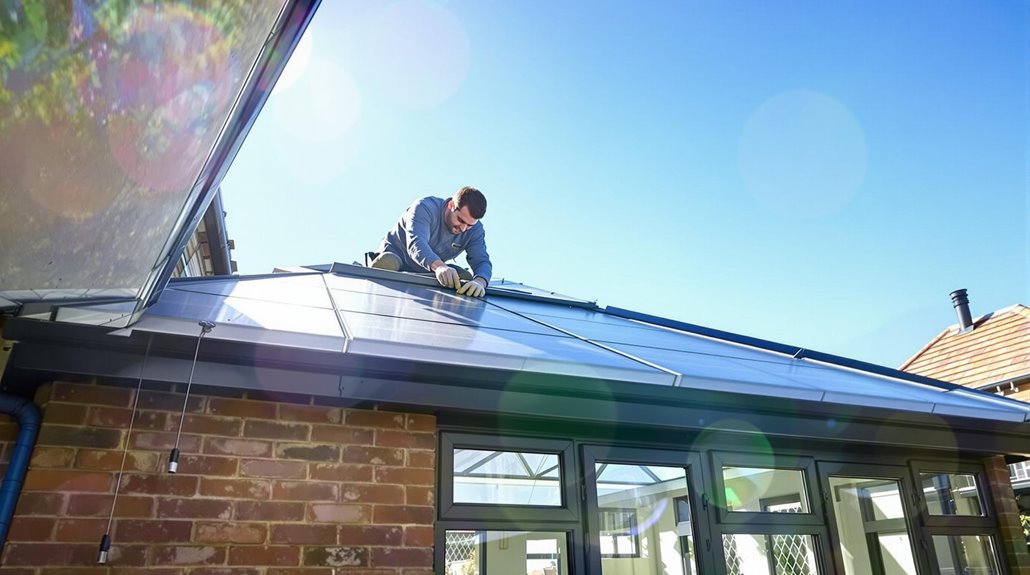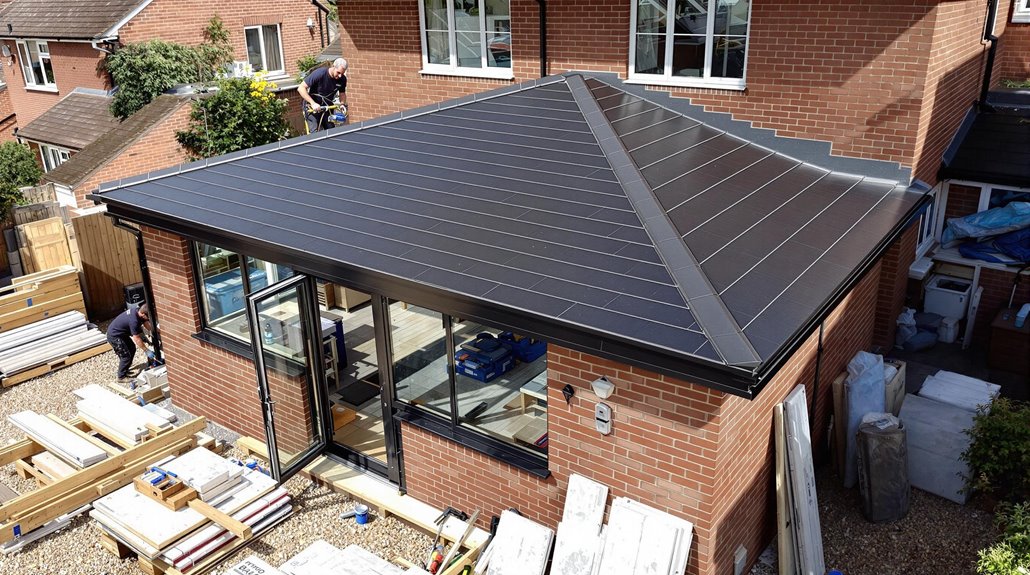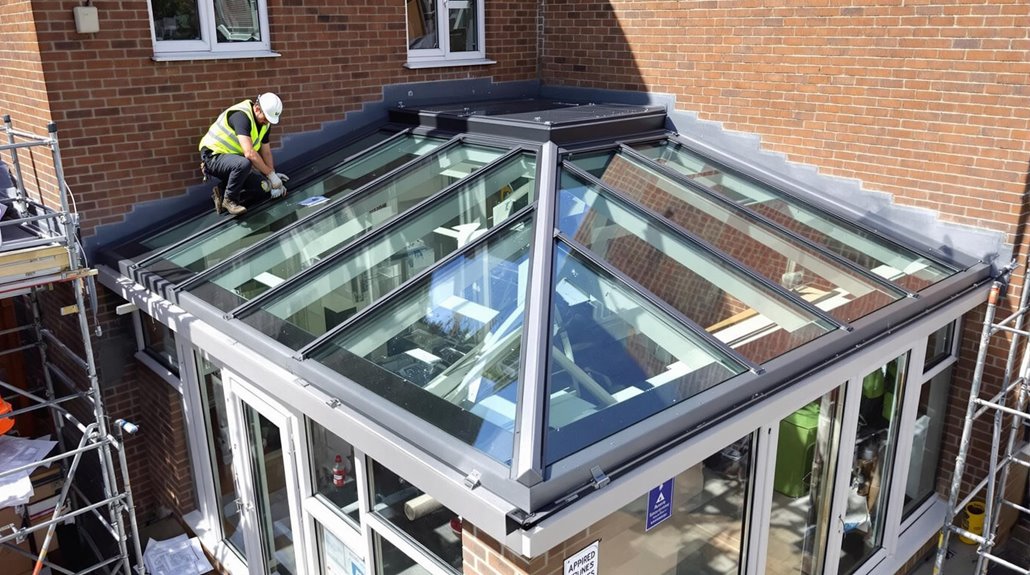I’ve helped countless homeowners transform their conservatories from seasonal spaces into year-round living areas, and it all starts with the roof. Your current polycarbonate or glass roof likely creates a greenhouse effect in summer and an icebox in winter – a problem that’s costing you money and limiting your home’s potential. The solution isn’t complex, but choosing the right materials and understanding the regulatory requirements will determine whether your investment pays off or becomes an expensive mistake.
Key Takeaways
- Modern conservatory roofs improve energy efficiency by up to 40%, enabling year-round use and reducing heating costs significantly.
- Three main material options: polycarbonate (£400-£800/m²), glass (£600-£1,200/m²), and tiles (£600-£900/m²) with varying insulation performance.
- Most roof replacements don’t require planning permission but must comply with building regulations for structural safety.
- Installation takes 1-5 days depending on material choice, with regional costs varying from £9,000-£18,000 across the UK.
- Roof replacement adds 5-10% to property value with 60-70% ROI, helping homes sell 25% faster than unmodernised conservatories.
Why Consider Replacing Your Conservatory Roof

While conservatory roofs typically last 15-20 years, I’ve found that replacing yours earlier can deliver substantial returns through enhanced performance and functionality. Your current roof likely struggles with temperature regulation, creating spaces that’re too hot in summer and freezing in winter. I’ve seen how modern insulated roofs eliminate these extremes, reducing your energy bills by up to 40% through improved thermal performance. These upgrades also allow you to enjoy natural light and outdoor views, which can significantly enhance your cooking and entertaining experiences.
You’ll gain year-round usability instead of seasonal limitations. Advanced materials resist UV damage, storms, and condensation issues that plague older roofs. Well-insulated, modern conservatories are particularly attractive to potential buyers, making your home more appealing on the market. I recommend replacement when you’re experiencing temperature fluctuations, high energy costs, or structural wear. Modern tiled or glass systems offer superior weather resistance, minimal maintenance requirements, and aesthetic upgrades that increase your property value while delivering consistent comfort.
Material Options: Polycarbonate Vs Glass Vs Tile
Three primary materials dominate today’s conservatory roof market, each delivering distinct performance characteristics that’ll impact your comfort, costs, and long-term satisfaction.
Polycarbonate offers the most budget-friendly entry point, but you’ll face minimal insulation and potential discoloration over time. It’s lightweight yet prone to temperature extremes that’ll make your space uncomfortable.
Glass roofs strike a middle ground—they’ll maximize natural light while providing better thermal performance than polycarbonate. You’ll get that modern, bright atmosphere perfect for plant growth, though expect mid-range pricing.
Tiled roofs represent the premium choice. They’ll deliver superior insulation, maintain consistent temperatures year-round, and boost your property value considerably. While requiring the highest upfront investment, you’ll enjoy decades of low-maintenance performance and energy savings that offset initial costs. Modern tiled systems can integrate glass panels for increased light while maintaining their superior thermal benefits.
Cost Breakdown by Material and Size

Understanding material performance characteristics sets the foundation, but you’ll need concrete pricing data to make informed decisions about your conservatory roof replacement.
I’ve analysed current UK pricing to give you realistic expectations. Polycarbonate remains your most budget-friendly option at £400–£800 per square metre, averaging £600. Glass commands premium pricing at £600–£1,200 per square metre, typically £900. Tile installations fall between these at £600–£900 per square metre, averaging £750. Additionally, choosing the right material can significantly influence your conservatory’s overall performance and comfort.
For practical context, a standard 3m x 3.5m roof replacement starts around £6,300 with polycarbonate but exceeds £9,450 with glass. Larger 4m x 4m conservatories begin at £16,000 for solid roofing. I’d recommend budgeting minimum £10,000 for standard projects, though UK averages sit around £4,000 for typical replacements. Solid roofs deliver 15 times better thermal efficiency compared to traditional glass or polycarbonate alternatives.
Labour Requirements and Installation Timeline
Once you’ve settled on your material choice, labour requirements become your next vital consideration for project planning. You’ll need at least two skilled workers for this job, as conservatory roof replacement demands coordinated teamwork and specialized expertise.
Your installation timeline depends on several key factors. Size directly impacts duration – larger conservatories require proportionally more time. Material choice proves essential: solid tiled roofs typically take five days to complete, while standard polycarbonate replacements finish within one to two days. Design complexity adds time when you’re dealing with custom angles, structural modifications, or framework adaptations. Understanding architect fees can help you budget effectively for this aspect of your project.
I recommend scheduling additional buffer time for preparation work, including existing roof removal and structural assessments. Weather conditions can also affect outdoor installation phases, so plan accordingly for potential delays. Glass roof installations require slightly more time than polycarbonate due to their superior insulation properties and more precise fitting requirements.
Regional Price Variations Across the UK
Where you live greatly impacts your conservatory roof replacement costs, with regional variations creating substantial budget differences across the UK. I’ve found London and South East projects typically cost £12,000-£18,000, while you’ll pay £9,000-£13,500 in North England and Wales. Labour rates drive these differences – you’re looking at £450-£550 daily in London versus £300-£400 up north. Additionally, home extension costs can vary significantly based on the complexity of the project and the specific materials chosen.
Material costs also fluctuate regionally. Glass roofing costs 5-8% more in London due to transport, whilst tiled materials run 7-10% cheaper in Midlands manufacturing hubs. Beyond standard pricing, access complexity significantly affects your final quote as difficult-to-reach conservatories require specialized equipment and additional safety measures. Coastal areas like Cornwall add 5-7% weather-proofing surcharges, and high-wind regions require reinforced structures costing 8-12% extra. Historic preservation zones can increase quotes by 15%, whilst affluent postcodes typically see 20% higher pricing across all project types.
Design Complexity and Custom Features Impact
While basic roof replacements follow straightforward pricing patterns, your conservatory’s design complexity and custom features dramatically reshape project costs and timelines. I’ve found that multi-angle roofs requiring specialized crews can extend basic 3-7 day installations to 10-14 days, with labor rates jumping to £300-500 daily per worker. Incorporating natural light into your design can significantly enhance the overall aesthetic and functionality.
Custom glazing like tinted or self-cleaning glass adds 5-20% to material costs, while automated ventilation systems increase quotes by £800-2,500. If you’re considering bespoke lighting, expect £300-1,200 plus electrical certification requirements. Acoustic insulation layers raise costs 10-25% but deliver 60-70% noise reduction.
Integration with existing rooflines extends timelines by 15-30%, particularly when matching tiles. Each skylight installation costs £150-500 and requires structural recalibration, making complexity planning essential for budget control. Modern hybrid roofs offer an excellent compromise by combining solid insulation panels with glass sections for optimal light distribution.
Planning Permission and Building Regulations

Most conservatory roof replacements bypass planning permission requirements entirely, though you’ll still need to navigate building regulations and neighbor notification procedures. I’ll guide you through the essential compliance steps that matter for your project.
Your replacement qualifies for exemption when you’re not exceeding the original height or extending roof projections beyond 150mm. However, you’ll face mandatory planning permission if your conservatory lacks proper original consent or sits within (Conservation Areas) a specific type of location constraint.
Building regulations remain non-negotiable regardless of planning status. You’ll need structural compliance for load-bearing capacity, thermal performance meeting current codes, and proper drainage systems. Professional installation certification protects your warranty.
The neighbor consultation scheme requires local authority notification, giving adjacent properties 21 days to object. Zero objections means automatic project approval. Tiled roof replacements generally require approval only in rare circumstances.
Energy Efficiency and Thermal Performance Upgrades
Since your conservatory’s thermal performance directly impacts both comfort and energy costs, upgrading to modern roofing materials represents the most effective single improvement you can make. I’ll walk you through the key options that deliver real results.
Tiled roofs achieve the lowest U-values at 0.12 W/m²K, while Eco-Shield polycarbonate maintains natural light with 0.83 W/m²K performance. Adding 28mm Eco-panels to existing roofs delivers 0.98 W/m²K efficiency through insulated infill powder coating. Additionally, investing in these upgrades may make you eligible for government grants that help offset costs.
You’ll prevent 25% heat loss that’s costing you money every winter, while blocking summer’s “sauna effect.” These upgrades reduce heat loss by 3× compared to older systems. Superior insulation also provides noise reduction for a quieter, more peaceful living space. With energy savings typically recovering costs within 5–7 years, you’re investing in proven technology that transforms unusable space into year-round comfort.
Long-Term Maintenance and Durability Considerations
Beyond the initial installation investment, your conservatory roof’s longevity depends on strategic maintenance planning and understanding material-specific durability characteristics. I recommend conducting bi-annual inspections to catch issues early, focusing on seals, drainage systems, and structural integrity. Glass roofs offer excellent longevity but require £100-£3000 for repairs when damage occurs, while tile systems can last 100 years with proper care.
Your maintenance budget should account for £100-£200 annually for routine upkeep, plus £100-£400 for minor repairs like sealant reapplication. Major structural repairs can reach £1000-£3000, making preventive care essential. Choose impact-resistant materials in storm-prone areas, maintain proper ventilation to prevent condensation, and invest in quality materials upfront to reduce lifetime costs considerably. Clean your conservatory roof every three months using a soft brush and warm, soapy water to prevent dirt accumulation and maintain optimal light transmission.
Return on Investment and Property Value Enhancement
While strategic maintenance protects your investment, the financial returns from upgrading your conservatory roof extend far beyond preservation costs. I’ve analyzed market data showing conservatory roof replacements deliver 60-70% ROI upon property sale, with installations adding 5-10% to overall home value. Your £3,000-£22,500 investment typically pays back within 10 years through £200 annual energy savings alone. Additionally, undertaking a house extension can further enhance your property’s appeal and value.
Estate agents report 25% faster sales for homes featuring modernized conservatories, as 78% of buyers prioritize thermal efficiency. You’ll avoid costly structural repairs averaging £2,000-£5,000 while creating year-round functional space that increases usable square footage. The market shows consistent monthly searches for conservatory roof replacements at 9,900 over the last year, demonstrating sustained homeowner interest in these upgrades. Premium materials like tiled roofs command higher resale premiums than polycarbonate alternatives, positioning your property competitively in today’s efficiency-focused market.
Conclusion
I’ve covered the technical aspects of conservatory roof replacement, from material specifications to installation requirements. You’ll need to evaluate your specific thermal performance needs, budget constraints, and local building regulations before proceeding. I recommend getting multiple quotes from certified installers and checking planning permission requirements in your area. The investment typically pays off through reduced energy costs and increased property value, making it a sound technical upgrade for most UK properties.
References
- https://consumer-advisory.co.uk/conservatory-roof-replacement-cost/
- https://www.checkatrade.com/blog/cost-guides/conservatory-roof-replacement-cost/
- https://homewindows.co.uk/conservatory-roof-replacement-cost/
- https://www.checkatrade.com/blog/cost-guides/roof-replacement-cost/
- https://www.theecoexperts.co.uk/conservatory/roof-cost
- https://hawthornswindows.co.uk/advantages-of-conservatory-roof-replacement-2024/
- https://www.renaissanceconservatories.co.uk/news/5-benefits-of-a-replacement-conservatory-roof
- https://ascgroupne.co.uk/conservatory-roof-replacement/
- https://www.lifestylewindows.co.uk/5-benefits-of-a-replacement-conservatory-roof
- https://snugconservatorysolutions.co.uk/assessing-the-added-value-of-conservatory-roof-replacement/

